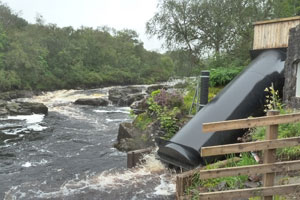
Gordon Mack, in the Not Exactly Fishing series, recounts a recent visit to the River Snizort, the Isle of Skye river where a fascinating renewable energy project sits side-by-side with an environmentally-precious, successful salmon and sea trout fishery, and relates his high-voltage experience.
IN RETROSPECT it had all the makings of a joke – a Scotsman, an Englishman and, well, actually two Frenchmen. But the payoff line was more exhilarating than humorous.
The two French in question were freelance TV journalists making a documentary for country sports enthusiasts back home on the delights of angling in Scotland. Their principal aim was to dispel a common French myth that fishing in this country is hugely expensive and largely the preserve of the gentry.
I was puzzled that they were not being fawned over by visitscotland given the huge free advertising plug in prospect. But that’s a story probably best left for another day.
In the absence of official tourist authority involvement, I was happy to offer contacts and suggestions that would amply demonstrate that prime fishing, be it game, coarse or sea, was readily available for very modest amounts of Euros and amid incomparable scenery.
The two are back next month for further filming and I hope to be able to provide a link to their programme in due course. But before they left, I had some business on the Isle of Skye and suggested they might like to join me to sample salmon fishing on the River Snizort, a gem of a West Highland spate river – and at £60 a day in the peak weeks, a perfect candidate for their brief.
But weeks of dry weather and a dismal forecast suggested that the journey north from central Scotland might not be worth the effort for the French team and they stayed behind.
Enter the Englishman – Derek Dowsett under whose careful management, the Snizort has been hugely improved in recent years and now challenges many larger waters for excitement and great returns, given the right conditions.
In truth my main reason for visiting Derek was to see at first hand his remarkable mini hydro-power scheme which is now in full production.

Using elements of an early 20th century water-powered generator on the river, Dowsett has created a state-of-the-art mini-hydro system which demonstrates that renewable energy initiatives can co-exist with precious environmental resources – such as the Snizort’s migratory fish runs – and still generate up to 35 kilowatts per hour of valuable electricity for the national grid.
When I visited, the Snizort was pouring a ton of water a second through the turbine and generating just over 30 kilowatts – enough to be able to service the entire needs of the neighbouring Skeabost Hotel when it switches over, and still generate a handsome financial return.
The river itself was not in full spate. Far from it. Slightly coloured, Derek said that surprise overnight rain had lifted it slightly – perhaps no more than a foot above normal. Still quite low in fact. Low water has been a difficult issue during 2012-13. Last year they had five months of almost no rain and this summer also produced an exceedingly dry spring.
Derek, however, remained optimistic that river would exceed 2012’s total of 108 salmon by the end of the season with sea trout perhaps double the previous year. And as I stood marvelling at the sophisticated technology deployed in his hydro scheme which has attraced hundreds of visitors, he extended an invitation to me to have an afternoon on a middle beat.
I had only a few hours to spare, but it was a generous gesture and too enticing to turn down. The Snizort has 12 beats on its ten mile length from Loch Duagrich to the sea. They are a mix of rugged falls and rapids and meandering oxbows bearing long slow deep pools as the river crosses low-lying pasture.
Beat 4 lies in the shadow of an old cemetery, no more than 15 minutes from the estuary – and ideal holding location for fresh-run fish; but in low water it can still be the graveyard of many hopes.
I took to the river at 2pm with a single-handed 11-foot rod, a size 7 sink tip line and a 12lb leader. My first four flies were all small size 12 doubles in yellow, black, silver and purple – a mix of Posh Tosh, Green Highlander, Stoats Tail and Silver Rat.
After an hour, I switched to a larger and heavier standard Cascade treble and within minutes was rewarded with a solid take from a powerful fish.

It turned out to be a cracking fresh-run cock of around 12.5 lb.
Within minutes, it seemed, I was into another. A smaller hen of about 5-6 lbs, that cartwheeled all over the pool before coming to the net. Both were photographed and carefully returned.
I’d hardly had time to draw breath, when a third – similar in size to the first – took the same fly, charged off down river at speed and round a tight bend. It was impossible to follow it because of a massive oxbow lake to my left, the line wedged between rocks on the opposite bank, and it was off.
Other fish were showing and the river was clearly packed. I glanced at my watch – 4.45pm and time was almost up. It was desperately hard to walk away: it had been an exhilarating and high energy three hours’ fishing which will burn brightly in my memory for many years.
Electrifying you might say.
2 Responses
The Mack is back?!
Sent from my iPhone
Ha! Mebbies aye, mebbies naw! Who knows . . . it was too good an experience not to write up.